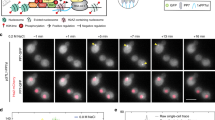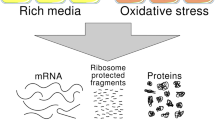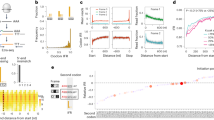Abstract
A universal feature of the response to stress and nutrient limitation is transcriptional upregulation of genes that encode proteins important for survival. Under many such conditions, the overall protein synthesis level is reduced, thereby dampening the stress response at the level of protein expression1. For example, during glucose starvation in Saccharomyces cerevisiae (yeast), translation is rapidly repressed, yet the transcription of many stress- and glucose-repressed genes is increased2,3. Here we show, using ribosomal profiling and microscopy, that this transcriptionally upregulated gene set consists of two classes: one class produces messenger RNAs that are translated during glucose starvation and are diffusely localized in the cytoplasm, including many heat-shock protein mRNAs; and the other class produces mRNAs that are not efficiently translated during glucose starvation and are concentrated in foci that co-localize with P bodies and stress granules, a class that is enriched for mRNAs involved in glucose metabolism. Surprisingly, the information specifying the differential localization and protein production of these two classes of mRNA is encoded in the promoter sequence: promoter responsiveness to heat-shock factor 1 (Hsf1) specifies diffuse cytoplasmic localization and higher protein production on glucose starvation. Thus, promoter sequences can influence not only the levels of mRNAs but also the subcellular localization of mRNAs and the efficiency with which they are translated, enabling cells to tailor protein production to the environmental conditions.
This is a preview of subscription content, access via your institution
Access options
Subscribe to this journal
Receive 51 print issues and online access
$199.00 per year
only $3.90 per issue
Buy this article
- Purchase on Springer Link
- Instant access to full article PDF
Prices may be subject to local taxes which are calculated during checkout




Similar content being viewed by others
References
Simpson, C. E. & Ashe, M. P. Adaptation to stress in yeast: to translate or not? Biochem. Soc. Trans. 40, 794–799 (2012)
Ashe, M. P., De Long, S. K. & Sachs, A. B. Glucose depletion rapidly inhibits translation initiation in yeast. Mol. Biol. Cell 11, 833–848 (2000)
Arribere, J. A., Doudna, J. A. & Gilbert, W. V. Reconsidering movement of eukaryotic mRNAs between polysomes and P bodies. Mol. Cell 44, 745–758 (2011)
Ingolia, N. T., Ghaemmaghami, S., Newman, J. R. S. & Weissman, J. S. Genome-wide analysis in vivo of translation with nucleotide resolution using ribosome profiling. Science 324, 218–223 (2009)
Decker, C. J. & Parker, R. P-bodies and stress granules: possible roles in the control of translation and mRNA degradation. Cold Spring Harb. Perspect. Biol. 4, a012286 (2012)
Brengues, M., Teixeira, D. & Parker, R. Movement of eukaryotic mRNAs between polysomes and cytoplasmic processing bodies. Science 310, 486–489 (2005)
Teixeira, D., Sheth, U., Valencia-Sanchez, M. A., Brengues, M. & Parker, R. Processing bodies require RNA for assembly and contain nontranslating mRNAs. RNA 11, 371–382 (2005)
Buchan, J. R. & Parker, R. Eukaryotic stress granules: the ins and outs of translation. Mol. Cell 36, 932–941 (2009)
Hoyle, N. P., Castelli, L. M., Campbell, S. G., Holmes, L. E. & Ashe, M. P. Stress-dependent relocalization of translationally primed mRNPs to cytoplasmic granules that are kinetically and spatially distinct from P-bodies. J. Cell Biol. 179, 65–74 (2007)
Martínez-Pastor, M. T. et al. The Saccharomyces cerevisiae zinc finger proteins Msn2p and Msn4p are required for transcriptional induction through the stress response element (STRE). EMBO J. 15, 2227–2235 (1996)
Hahn, J.-S. & Thiele, D. J. Activation of the Saccharomyces cerevisiae heat shock transcription factor under glucose starvation conditions by Snf1 protein kinase. J. Biol. Chem. 279, 5169–5176 (2004)
Susek, R. E. & Lindquist, S. Transcriptional derepression of the Saccharomyces cerevisiae HSP26 gene during heat shock. Mol. Cell. Biol. 10, 6362–6373 (1990)
Trotter, E. W. et al. Misfolded proteins are competent to mediate a subset of the responses to heat shock in Saccharomyces cerevisiae. J. Biol. Chem. 277, 44817–44825 (2002)
Wiederrecht, G., Seto, D. & Parker, C. S. Isolation of the gene encoding the S. cerevisiae heat shock transcription factor. Cell 54, 841–853 (1988)
Kedersha, N. & Anderson, P. Stress granules: sites of mRNA triage that regulate mRNA stability. Biochem Soc. Trans. 30, 963–969 (2002)
Stöhr, N. et al. ZBP1 regulates mRNA stability during cellular stress. J. Cell Biol. 175, 527–534 (2006)
Bregman, A. et al. Promoter elements regulate cytoplasmic mRNA decay. Cell 147, 1473–1483 (2011)
Trcek, T., Larson, D. R., Moldón, A., Query, C. C. & Singer, R. H. Single-molecule mRNA decay measurements reveal promoter-regulated mRNA stability in yeast. Cell 147, 1484–1497 (2011)
Ghaemmaghami, S. et al. Global analysis of protein expression in yeast. Nature 425, 737–741 (2003)
Haim-Vilmovsky, L. & Gerst, J. E. m-TAG: a PCR-based genomic integration method to visualize the localization of specific endogenous mRNAs in vivo in yeast. Nature Protocols 4, 1274–1284 (2009)
Gibson, D. G. et al. Enzymatic assembly of DNA molecules up to several hundred kilobases. Nature Methods 6, 343–345 (2009)
Longtine, M. S. et al. Additional modules for versatile and economical PCR-based gene deletion and modification in Saccharomyces cerevisiae. Yeast 14, 953–961 (1998)
Hansen, A. S. & O’Shea, E. K. Promoter decoding of transcription factor dynamics involves a trade-off between noise and control of gene expression. Mol. Syst. Biol. 9, 704 (2013)
Brandman, O. et al. A ribosome-bound quality control complex triggers degradation of nascent peptides and signals translation stress. Cell 151, 1042–1054 (2012)
Lutfiyya, L. L. et al. Characterization of three related glucose repressors and genes they regulate in Saccharomyces cerevisiae. Genetics 150, 1377–1391 (1998)
Langmead, B., Trapnell, C., Pop, M. & Salzberg, S. L. Ultrafast and memory-efficient alignment of short DNA sequences to the human genome. Genome Biol. 10, R25 (2009)
Otsu, N. A threshold selection method from gray-level histograms. IEEE Trans. Syst. Man Cybern. 9, 62–66 (1979)
Ruxton, G. D. The unequal variance t-test is an underused alternative to Student’s t-test and the Mann–Whitney U test. Behav. Ecol. 17, 688–690 (2006)
Cook, K. E. & O’Shea, E. K. Hog1 controls global reallocation of RNA Pol II upon osmotic shock in Saccharomyces cerevisiae. G3 (Bethesda) 2, 1129–1136 (2012)
Acknowledgements
We thank A. Subramaniam, S. Mukherji, V. Denic, B. Stern and M. Waldram for feedback on the paper, members of the O’Shea, Denic, and Calarco laboratories for discussions, and C. Daly for sequencing assistance. This research was supported by the American Cancer Society and the New England Division Funding A Cure initiative (B.M.Z.) and the Howard Hughes Medical Institute (E.K.O.).
Author information
Authors and Affiliations
Contributions
B.M.Z. collected and analysed the data. B.M.Z. and E.K.O. designed the experiments and wrote the manuscript.
Corresponding author
Ethics declarations
Competing interests
The authors declare no competing financial interests.
Extended data figures and tables
Extended Data Figure 1 Glucose starvation causes a reduction in overall translation, along with gene-specific changes in ribosome and mRNA read density.
a, Sedimentation profile of logarithmic-phase cells of strain BY4741 grown in SCD medium. The arrow marks the sedimentation of the 80S ribosome. b, Sedimentation profile of cells of strain BY4741 grown in SCD medium and then transferred to the same medium lacking glucose for 15 min. c, Ribosome and mRNA read density across the HXK1 mRNA during logarithmic-phase growth in glucose-rich conditions and after 15 min of glucose starvation. For the tracks labelled “mRNA”, the number of mRNA reads is shown normalized to the total number of sequence reads for that sample (in reads per million reads (RPM)). For the tracks labelled “Ribosome”, the number of ribosome reads is shown normalized to the total number of reads for that sample (in RPM). The initiation region was defined as a 36-base-pair (bp) region that contains 16 bp upstream of the AUG and 20 bp downstream. The downstream region is defined as the rest of the ORF.
Extended Data Figure 2 Differences in ribosome occupancy of transcriptionally upregulated mRNAs upon glucose starvation are reproducible and independent of the mRNA isolation method.
Ribosomal profiling was performed on strains BY4741 and EY0690 grown in glucose-rich and glucose-starvation conditions. The fold change in ribosome occupancy versus the fold change in mRNA level 15 min after cells are transferred to medium lacking glucose is shown. Genes are represented by individual symbols on the plot. Ribosome occupancy was calculated for the coding region of each gene by dividing the total number of ribosome sequence counts in an ORF (normalized to the total number of aligned reads in RPM) by the number of mRNA sequence counts (RPM) in the same sequence. The coloured symbols in each panel show the gene classes defined from BY4741 ribosomal profiling of non-poly(A)+-selected mRNA replicate 1 in a (identical to Fig. 1a). Red symbols denote genes that have upregulated mRNA levels (>2.5) and higher ribosome occupancy (>0.09). Blue symbols denote genes that have upregulated mRNA levels (>2.5) with lower ribosome occupancy (<−1.0). Green symbols denote genes that have decreased mRNA levels (<−1.25) during glucose limitation. While downregulated mRNAs are present at decreased levels, many of them have increased ribosome occupancy, and this subset of mRNAs is enriched for genes involved in ribosome biogenesis (26 of 84; false discovery rate (FDR)-adjusted P = 9.9 × 10−4) by gene ontology analysis. Similarly, it has previously been observed that ribosome biogenesis mRNAs are present at decreased levels and have increased polysome association during early glucose starvation3. Black symbols represent all other genes in the genome for which measurements were obtained. The upregulated, higher ribosome occupancy genes (HSP30, HSP26, HSP12 and HSP104) and the upregulated, lower ribosome occupancy genes (GLC3, GSY1, GPH1 and HXK1) are labelled in each panel. a, BY4741 non-poly(A)+-selected RNA, ribosome profiling replicate 1 (same as Fig. 1a). b, EY0690 non-poly(A)+-selected RNA, ribosome profiling replicate 1. c, BY4741 poly(A)+-selected RNA, ribosomal profiling replicate 1. d, EY0690 poly(A)+-selected RNA, ribosome profiling replicate 1. e, BY4741 poly(A)+-selected RNA, ribosomal profiling replicate 2. f, EY0690 poly(A)+-selected RNA, ribosomal profiling replicate 2.
Extended Data Figure 3 The genes corresponding to upregulated mRNAs have increased RNA polymerase II occupancy upon glucose starvation.
The mRNA levels of the indicated genes were measured by RNA sequencing (RNA-seq) after 15 min of glucose starvation, and these levels were divided by the levels obtained during growth in glucose-rich medium to obtain the fold-change values. The measurements were made on independent biological samples (with strains BY4741 and EY0690), and the values are presented as the mean ± s.e.m. The RNA polymerase II occupancy was measured after 15 min of glucose starvation, and then this occupancy was divided by the occupancy in glucose-rich medium to obtain the fold-change values. RNA polymerase II occupancy was calculated from three independent biological replicates of BY4741, and the values are presented as the mean ± s.e.m.
Extended Data Figure 4 Formation of mRNA foci is dependent on MS2-binding sites and does not occur in cells growing exponentially in medium containing glucose.
In the absence of mRNA containing MS2-binding sites, MS2–GFP remained diffusely localized during glucose starvation (first two rows, first column). When glucose was present in the medium, MS2 mRNA and the P body marker Dcp2–RFP were diffusely localized during the logarithmic phase of growth.
Extended Data Figure 5 Timing of lacZ-MS2 induction relative to glucose starvation affects mRNA localization, whereas timing or level of induction during glucose starvation has no effect.
The expression of lacZ-MS2 was either uninduced (0 µg ml−1), induced to different extents with varying concentrations of doxycycline during glucose starvation (2, 4 or 20 µg ml−1), induced at different times during glucose starvation (7.5 min of glucose starvation with no doxycycline, then 20 µg ml−1 doxycycline for the final 7.5 min of glucose starvation) or induced before glucose starvation (20 µg ml−1 doxycycline during logarithmic phase and none during glucose starvation) in the EY2897 strain. a, Localization of the mRNA was visualized using MS2–GFP after 15 min of glucose starvation for all strains. Dcp2–RFP was used to visualize P body localization. lacZ-MS2 expression before glucose starvation caused high co-localization with P bodies, while mRNA induction during glucose starvation caused the formation of mRNA foci that both co-localized with P bodies and were distinct from P bodies. b, Quantification of the localization data shown in a. The values are presented as the mean ± s.e.m. and were calculated as follows: in quadruplicate (two biological replicates with two technical replicates per sample) for 0, 2, 20 µg ml−1 doxycycline in the absence of glucose and 20 µg ml−1 doxycycline in the presence of glucose; and in triplicate on technical replicates for 4 and 20 µg ml−1 doxycycline 7.5 min after the removal of glucose. c, Quantification of lacZ-MS2 mRNA levels 15 min after glucose starvation. The fold change was calculated compared with the uninduced sample (0 µg ml−1 doxycycline) and normalized to ACT1 abundance, as calculated from three independent biological replicates.
Extended Data Figure 6 Promoter sequences determine mRNA localization upon glucose starvation.
a, The promoter and 5′ UTR of the indicated genes were fused upstream of CFP–MS2 in the plasmid pRS305 and integrated into EY0690. The mRNA localization was measured after 15 min of glucose starvation. The values are presented as the mean ± s.e.m. from Fig. 3c as calculated on a minimum of 30 cells in quadruplicate (two biological replicates with two technical replicates per sample). b, Localization of CFP–MS2 mRNAs driven by chimaeric HSP26 and GLC3 promoters or synthetic (STRE or STRE+HSE) promoters upon glucose starvation. The values are presented as the mean ± s.e.m. from Fig. 4b as calculated on a minimum of 25 cells in quadruplicate (two biological replicates with two technical replicates per sample).
Extended Data Figure 7 mRNA levels of CFP–MS2 under different conditions controlled by various promoter–UTR combinations.
a, The relative levels of CFP–MS2 mRNA, under the control of the indicated promoter and UTR regions 15 min after glucose starvation, as measured by qPCR. The values are normalized to ACT1 abundance and are presented as the mean ± s.e.m. relative to the HSP26prUTR-CFP levels and calculated from three independent biological replicates. b, Fold change in CFP–MS2 mRNA abundance after 15 min of glucose starvation (−Glu) or after treatment with 10 mM AZC for 2 h (+AZC), relative to levels during logarithmic-phase growth in glucose-rich medium. CFP–MS2 mRNA was measured by qPCR and normalized to ACT1 levels. The values are presented as the mean ± s.e.m. as calculated from three independent biological replicates.
Extended Data Figure 8 Synthetic STRE±HSE promoter sequences.
The STRE±HSE elements were placed upstream of an attenuated CYC1 promoter17 driving the expression of CFP–MS2. A Mig1-binding element was included upstream of the promoter elements to reduce expression pre-starvation. The Mig1-binding element is shown in grey; the 4× STRE is labelled in blue; the 3× HSE is labelled in red; and the CYC1 promoter is labelled in yellow.
Supplementary information
Supplementary Information
This file contains Supplementary Tables 1-3. (PDF 313 kb)
Rights and permissions
About this article
Cite this article
Zid, B., O’Shea, E. Promoter sequences direct cytoplasmic localization and translation of mRNAs during starvation in yeast. Nature 514, 117–121 (2014). https://doi.org/10.1038/nature13578
Received:
Accepted:
Published:
Issue Date:
DOI: https://doi.org/10.1038/nature13578
This article is cited by
-
Extracellular vesicles could be a putative posttranscriptional regulatory mechanism that shapes intracellular RNA levels in Plasmodium falciparum
Nature Communications (2023)
-
Fitness cost associated with cell phenotypic switching drives population diversification dynamics and controllability
Nature Communications (2023)
-
Enhancers regulate 3′ end processing activity to control expression of alternative 3′UTR isoforms
Nature Communications (2022)
-
Context-specific regulation and function of mRNA alternative polyadenylation
Nature Reviews Molecular Cell Biology (2022)
-
PTENα functions as an immune suppressor and promotes immune resistance in PTEN-mutant cancer
Nature Communications (2021)
Comments
By submitting a comment you agree to abide by our Terms and Community Guidelines. If you find something abusive or that does not comply with our terms or guidelines please flag it as inappropriate.



